Norbiton (7)
By:
January 15, 2021
Anatomy of Norbiton: Bibliotechnical
“Panofsky viewed this loss [of ancient painting] as salutary for the spontaneity of Renaissance painting, yet Renaissance artists felt irreparable bereavement.”
Hetty Joyce, ‘Grasping at Shadows: Ancient Paintings in Renaissance and Baroque Rome’, in The Art Bulletin, Vol. 74, No. 2 (June 1992) p. 219
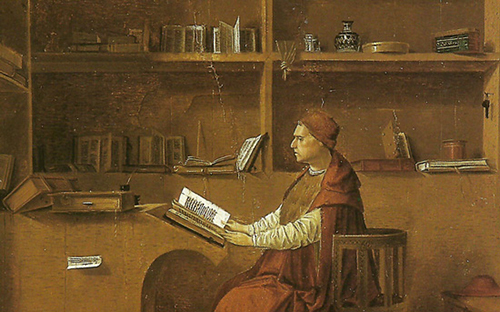
– SAINT JEROME IN HIS STUDY
ANTONELLO DA MESSINA
Some of my most tedious, hence productive, hours have been spent in libraries.
This is nothing remarkable in the career of a (failed, ex-) academic. Those libraries were mere repositories of books, stratifications of printed matter like dead and compressed sea creatures from which you hope, with professional circumspection, one day to squeeze a drop of oil; there is a curious opiate power in the Dewey Decimal system, in the copiousness of an academic library. Go through the doors and it is hard to leave. And so year after year I drowsed and read and transcribed.
Time was when libraries were the clearing houses of the world’s knowledge, when they were the places everything happened. Not for many years now, though. Now, if you are looking for the important stuff happening in our culture you won’t sit in a library. Instead you will attend production meetings at TV channels, design meetings at tech companies in California; you will note anything happening in a laboratory, anything on a trading floor, visit MIT, interrogate think tanks, fly into Mumbai, Shanghai.
I use the word important in an enlarged sense.
Libraries are the Hogsmill River of our civilisation, places of silt and sedimentation; ecologically interesting, perhaps, but hardly dynamic.

– HOGSMILL RIVER, APPROACHING BERRYLANDS
Hunter Sidney says that back in the 1980s he used to go in his lunch hour to the London Library and dawdle among its shelves. It was a place, he recalls, where a certain class of individual emerged; in here, people who were displaced, invisible, forgotten in the outside world started to form distinct social groupings, known hierarchies, even though they mostly never spoke to one another. It was, he specifically noted, a place for émigrés who couldn’t get a ticket at the British Library, central European intellectuals trying to maintain contact with whatever it was they had once been.
The residents of the London Library, Hunter Sidney concluded, were hiding. If you want a sense of how little you count for, he says, do not look up at the bewildering stars, look at the shelves of a library. Read a book a day for fifty years and you’ll read 18262 books or thereabouts, depending on the spread of leap years. In your life. No one reads a book a day, you’d never have time to think in all that blizzard of other voices, but just say. 18262 books in a lifetime of mad reading. The London Library, by no measure immense, has, what, a million? Carrying an idea into a space like that is like carrying a candle into the sun. No one will ever find you, or your idea.
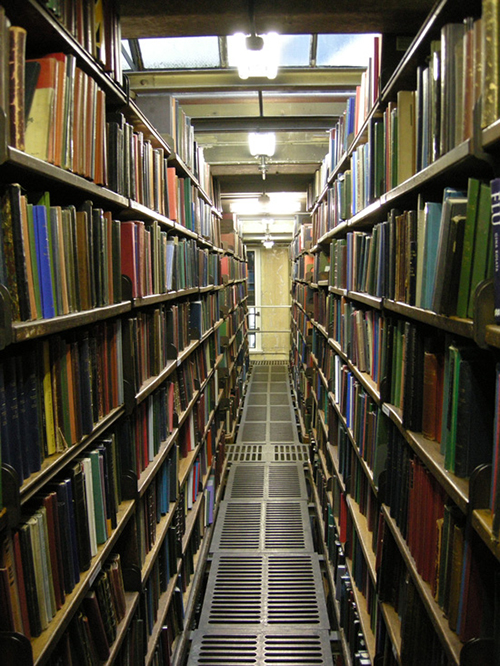
– PHOTO: GRINDTXX (OWN WORK) [CC BY-SA 3.0 (HTTP://CREATIVECOMMONS.ORG/LICENSES/BY-SA/3.0)], VIA WIKIMEDIA COMMONS
Hunter Sidney says that it was sitting there, looking out over this wreck of intellectual humanity that he came to the (for him unpleasant) realisation that a book does not change its reader’s life; at best a book may alter the distribution, move the mental furniture about a little; but in general books are mere ballast to a becalmed soul, and a hall of mirrors to a tortured one.
He concluded that, as a reader, the only rational approach to a library of this sort or to all libraries or indeed to the IDEA OF LIBRARY is one of dereliction. You work out, sub-consciously or pragmatically, what you can safely ignore (most things), and when to stop (sooner, not later).
He further concluded, glumly, that there is no analogous rational approach for a writer.
Five years on and he was working on the anti-literature, which is indexed in no library.
Silted up and slow-moving they may be, but libraries are not entirely dead places, memorial cairns of the written word; like me, they only appear so.

An ex-colleague of mine from South Carolina, William something Smith the Third, once saw me sitting reading in a corner of a public space at work and when he came back an hour later there I still was, still reading. He hooted with laughter and said that if you set up a camera and filmed for a day and then sped it up there’d be a blur of activity and movement and me, sitting motionless in the middle of it all.
I’m not so sure about that. I think that, like one of those deep sea starfish, if you sped up the camera of my life you’d see me creep along the sea bed, harvesting nutrients from rock and coral.
I observe that my books, similarly, move around on my shelves over time. Some are grouped together (by chance?), but mostly there is no system. I take a book down, I leave it lying around for a few weeks, I stuff it back anyhow. I never really know where a given book is. Sometimes I start to look for one and just give up.
There are ways of sorting libraries. Systems which pin books down in place. But then where would that lead? I would sit and stare at those static shelves and my life would be no further along, just more obviously psychotic. It would be like nailing down the starfish because each time you looked back you thought it had moved but could not be sure. So I nail down no starfish and the shelves continue to mutate; if you took Bill Smith’s time-lapse film of the room, the books would be flickering around me and I’d just be sitting here, my feet on the desk.
As I say, libraries are where you go to watch the sedimentation of a culture. But this is my culture, my own sedimentation I am watching. It is a little chaotic, but not uninteresting.
We have in NORBITON: IDEAL CITY a library, known as Solomon’s Library. It is our public library—public in the sense that there are other people there, it is open to other citizens of the Ideal City. In material terms it is not extensive, but then it is not a repository of books so much as a place where stuff pertaining to books happens. You can talk, read, yawn, scratch, drink tea and doze. And in that rich somnolent state appropriate to the culture of books, some other bit of you is waking up, is hyper-aware, attentive to the cockroach scurry of thought and memory.
Our library is not copious, then, but it is rarefied. What happens on the shelves is not a backdrop to the rest. This is a place where things happen, and one of the things that happens is the slow filtering and sorting and sifting of the books on the shelves.
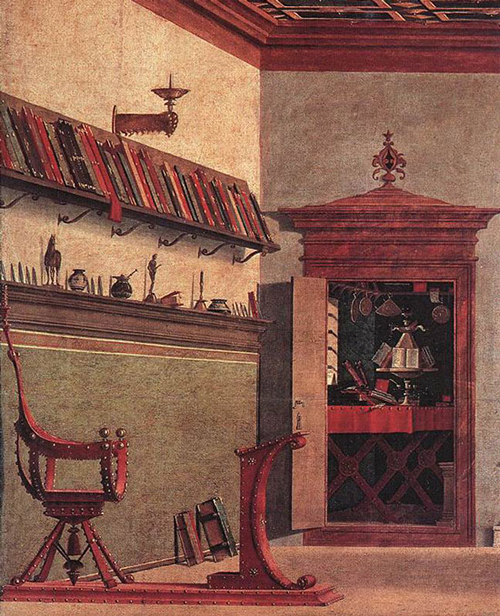
– SAINT AUGUSTINE IN HIS STUDY
VITTORE CARPACCIO
Borges wrote a story about the universe as a library of all possible books. Each book is 410 pages long, and of a uniform format. Each is made up of a random (unrepeated) sequence of twenty-five characters—twenty-two letters, the comma, the full-stop, and the space. Given the restrictions on length and format, and the limited alphabet, it is not infinite. But we can nevertheless say that it contains all possible books that ever have been and ever will be written (stretched, if need be, across multiple volumes), all possible variants on those books, all possible translations into all possible, actual, imagined language; and in between each book, or variant of book, an almost infinite series of gibberish books, like endless irrational numbers filling the spaces between their rational counterparts. Somewhere in this near-infinity, there will be a true catalogue of the library’s contents, a true explanation of its organisation, and no end of false catalogues and explanations.
A library, then, with an informational content of, approximately, zero.
Who would bother to set off, in such a library, in search of legible books? How would you recognise such books when found? Such a pursuit would correspond to a Kabbalistical word-turning, or to an alchemical combination and re-combination of all the world’s substances under all conceivable conditions in search of a goal or a truth both ill-defined and half-forgotten in the process itself, an endless iteration like a compulsive disorder.
No, you would potter about in whichever cell you happened to occupy, the books so much unregarded ornament or decoration, a baroque curiosity.
Or, by another measure, you might set off in search something to read, simply so that through movement you might counter the tedium of sitting on your arse in a library.
The libraries of the quattrocento, like our Norbiton library but unlike that of Borges or the London Library, were in the first place spare, sparse, even; and in the second were ambulatory spaces.
Bruce Chatwin in The Songlines discusses the rhythm of walking and maintains that, each of us at bottom being a nomadical pastoralist manqué, we are at our happiest walking, our most reflective. Without bothering to give this too much thought I find it to be convincing; and I discover that very rhythm reflected in the intercolumniation of, for example, the library of San Marco in Florence. This is a cool place where thought can go for a stroll in the heat of the afternoon.
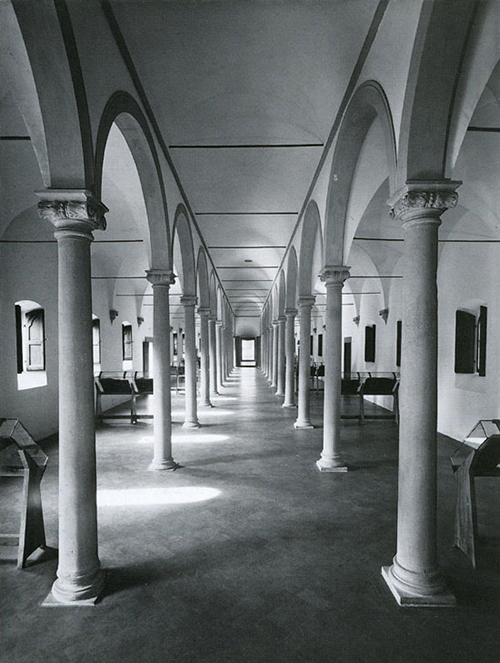
– LIBRARY OF SAN MARCO
MICHELOZZO MICHELOZZI
The library, commissioned by Cosimo de’Medici, was designed and built by Michelozzo Michelozzi, who was also responsible for the Palazzo Medici. It is a place of deliberate austerity—the library dates from the 1430s, and the difference between the solid, mercantile 1430s and the physically sumptuous, intellectually superheated 1480s cannot be overstated—as witness the capitals to the columns: a plain ionic, none of that composite sculptural flourish so common in Michelozzo’s other work—for instance, the capitals in the courtyard of the Palazzo Medici.
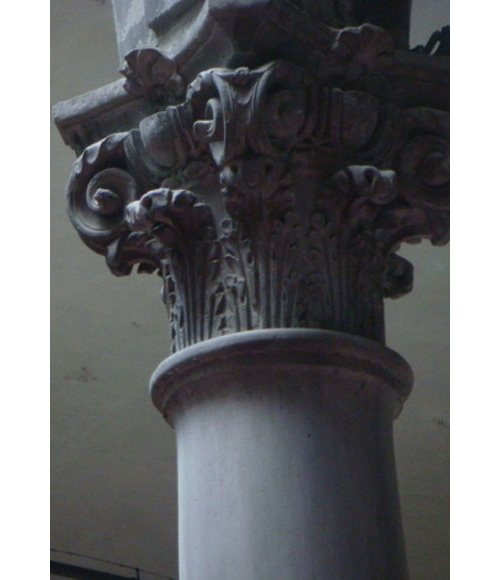
– CAPITAL IN THE COURTYARD OF THE MEDICI PALACE
MICHELOZZO MICHELOZZI
It is, then, a paradigm of clarity, but also of proportion and rhythm. A place where the thinkable has its rational limits. A place, moreover, where each co-ordinate of knowledge—each book—is not merely a relational point in an extensible system, but a known, substantial object.
So, the Renaissance library is a form of thought—clear, discriminating, spacious. And ambulatory.
Solomon’s library, similarly, is built to a super-discriminatory specification. But this is not at first apparent. The downstairs—the bookshop—is a space overwhelmed by a tide of a printed matter, a clearing house of unwanted publication. There are local topographies and technical journals in amongst the graceless embossed covers of cheap thrillers and throwaway biographies; there are sporting annuals and pointless old black-and-white art books from the days when colour printing was expensive, and ancient books on collecting porcelain and furniture that can be relevant to no one (surely?), and a few nice editions of this or that thrown in among them. In the back office, where Solomon sits at his desk hunched over some book or other, is a glass cabinet with whatever comes in of antiquarian interest. It could be, in short, one fragment of Borges’s library of everything—so random and insufficiently coherent that it would not much signify if the books were filled with letters arranged at hazard.
Upstairs, however, it is different. Upstairs, for one thing, the shelves are uniform. They are not expensive, or of antique design; they are solidly constructed of plain wood, pine, it might be. The books are not at first sight of any special value (although they are as it happens dizzily overpriced). But this upstairs area, where books are rarely sold, is the fruit of two coinciding projects in Solomon’s life. His re-reading project, and his proof-reading project.
Solomon is an autodidact. He is now in his late sixties, or perhaps early seventies. When he was in his mid-forties, having read particularly widely in the fields of literature, history, art and philosophy, and having tried and failed to publish articles on various subjects in semi-scholarly journals, and one slim book on varieties of pagination in the incunabula, he was struck by the thought that, if he set himself to re-read everything he had so far read in life, he would just about have time.
In a way not untypical of the autodidact he had kept an exhaustive reading record since he was a teenager, in an alphabetized notebook. He had always read good books, meaning, he had for the most part only had patience with classic titles or titles of repute; there were a few books he still wished to read, but he reasoned to himself that he had no desire to spend the rest of his life reading books that were less good than those he had already read, and that since, as a young man, he had not understood how to read, or rather, how to organise his reading so that book spoke clearly to book, there was every reason to go back and start again, this time imposing order and clarity on what had, the first time round, been but virgin jungle to him.
He went through his list of books, excising those he thought unworthy of his time, multiplying translations of foreign texts where necessary, and drawing up a secondary list of key books he would like to have read but had not, and for these he allowed himself one year (like Noah, looking at his watch as the rain starts to fall, to see which last bedraggled creatures might make it up the ramp); he then worked out a loose and flexible plan of groupings of books, and natural progressions from one area of reading to the next, and allowed himself a percentage of time for new texts that would have to be added, and a (much smaller) percentage of time for texts that had yet to be written which he might need to read. And off he went.
Solomon is now twenty to twenty-five years into the re-reading project and it is not, by his own admission, going all that well, because he rapidly became entangled in another problem. All texts, however good, are subject to the possibility of typographical error. It was inevitable, but typographical error came for Solomon to overlay editions like flickering mirrors of doubt. Solomon had a sharp eye for detail and a typo made him wince. He began therefore, here and there, to make his own judgements, and pencil his emendations in the margins of the books he read (which he ensured were otherwise clean) in his precise 2H hand, and this practice became an obsession, so that he ceased to trust even the best editions, could not restrain himself, by his own admission, from just running the rule over them.
Thus every book on the shelves in the upstairs of his shop came to be assessed, vetted, annotated in this way. He was prepared to sell them, he told me, because he kept a faithful record of every change he made in a separate catalogue of notebooks which he kept in a fireproof safe under his desk. If a book was sold—a rare occurrence, since he now priced in his own labour costs—he would simply search out a new one, copy in the emendations, and pocket the difference, meanwhile putting the new version up for sale at a newly-inflated price to take into account the trouble of sourcing and re-annotating the volume. In the process, he said, he was able to reacquaint himself with whatever book it happened to be, however briefly.
Each day he would arrive at the shop, open it up, make a cup of what he calls Hong Kong milk tea (a Lipton’s tea bag and Carnation condensed milk—very refreshing, he claims), open the safe, take out the notebook relevant to the edition he was currently working on, and begin to read, running a piece of stiff white cartridge paper under each line as he went. This was Solomon in his sensorium.
Solomon, if he knew it, is an inheritor of the humanist instinct towards philology, accuracy of copy-text, clarity of transmission, which was bound up, in the case of the early humanists, with an instinct to strip out the excrescences of medieval Latin, to restore the purity of the classical language, such that the whole stile nuovo in architecture, with its exposing of the classical roots of gothic forms was, according to Gombrich, evidence of humanistic cross-fertilisation.
But Solomon makes a different, much vaster, claim. His work, he says, is not one of correcting or putting right or purifying, but merely pointing up—that all typographical error, in his view, is a form of parapraxis; that as parapraxis is a sort of vent to irrational desire, so in misprints and typographical error we could, if we had sufficient data, sufficient patience and sufficiently accurate sensibility, trace the subconscious desire of a civilisation. As the age of reason imposed greater strictness and orthodoxy on spelling and punctuation and typesetting, it also imposed greater straightjacketing on desire, and more precisely-drawn margins between acceptable and unacceptable, compared with the looser configuration of, say, 17th practice, or oral tradition—which he secretly suspected to have a wilder miscopying parapraxis of its own.
If cultures evolve, he says – and there are those who talk of cultural evolution—then here perhaps is your mechanism. Here is your mutation. People misreading, mishearing, misunderstanding. Non-random errors in the transmission code, a willed evolution, a culture wrested unconsciously but not irrationally in a certain direction—we all know what direction: call it the Entropic Will.
Like an inhabitant of Borges library, what he has embarked on is a Talmudic search not for the book of his own life nor for the true name of God, but for the bifurcating fault lines of chaos.
Étienne-Louis Boullée, Norbiton’s Paper-Architect-in-Residence (deceased), designed a library in 1785 for the King. A library so immense that in it any individual, the King no less and perhaps more than most, would be reduced to an irrelevance.
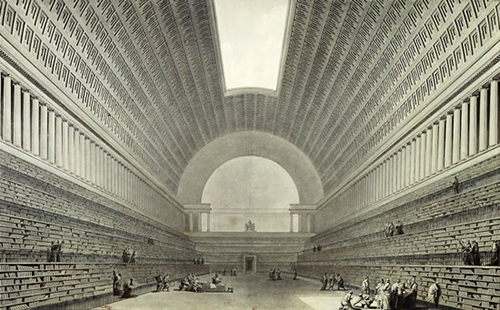
– DEUXIEME PROJET POUR LA BIBLIOTHEQUE DU ROI (1785)
ÉTIENNE-LOUIS BOULLEE
Let us imagine. The King needs a book to read, so he goes into his library. Perhaps he is wearing his dressing gown and slippers, and carrying a candle. In this homogenous, undifferentiated space, he is nothing. It is dark, there is only an immensity of blackness out beyond the imbecile candlelight, and the immenser blackness of the books beyond that. So the King is nothing, the books are infinite but insignificant, space is all. His Highness shuffles to a shelf, takes the first book his hand will reach—with luck an encyclopaedia, or an anatomy, something with a simple and soporific and clearly navigable structure—and returns to the confines of his bed-chamber, pursued by the cacophonic echo of his own slippered footstep.
And here, you feel, is the real insight, the real genius of this (never built) structure: it is an essay not on the space, but on the acoustical properties of a library. Turning over one crackling leaf of a book would be an explosion of sound. Coughing, shuffling, wheezing, muttering, the sounds of a thousand people drowsing and studying, would accumulate through the day, float up and aggregate like dense and louring airs under that coffered vault.
A jobbing contemporary architect would never build such a space, for such a purpose, but if he did he would place a trickling fountain somewhere or other, a white noise generator to absorb the particular sounds. Étienne-Louis Boullée is no jobbing architect. He understands that in this space you—reader, academician, king—are nothing; but your lightest thought, the snap of a neuron, the flicker of a synapse, is an act of reverberating magnitude which a mere multitude of books might baffle, but a library which is all space will relentlessly and optimistically amplify.
How, asks Étienne-Louis Boullée, do we imprint ourselves on the Cosmos? Not by the dried and preserved slug-trace of our reading, but, just perhaps and if at all, by the footfall reflected back to us as we walk from book to book, a sonar trace of progress, a blip blip blip, a searching for evidence of a solid object out there in the unsounded deeps, as we walk over its surface, and read, and walk, and alternately read, and walk, and read.
Anatomy of Norbiton on HILOBROW
Original post at Anatomy of Norbiton: Bibliotechnical
Anatomy of Norbiton
Short Life in a Strange World by Toby Ferris
Toby Ferris on Twitter
On the Paintings of Pieter Bruegel by Toby Ferris
All tapir illustrations by Anna Keen: portfolio

